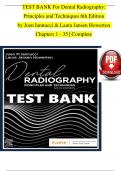Exam (elaborations)
TEST BANK For Dental Radiography: Principles and Techniques 6th Edition by Joen Iannucci & Laura Jansen Howerton, Verified Chapters 1 - 35, Complete Newest Version
TEST BANK For Dental Radiography: Principles and Techniques 6th Edition by Joen Iannucci & Laura Jansen Howerton, Verified Chapters 1 - 35, Complete Newest Version TEST BANK For Dental Radiography: Principles and Techniques 6th Edition by Joen Iannucci & Laura Jansen Howerton, Verified Chapters 1 -...
[Show more]



